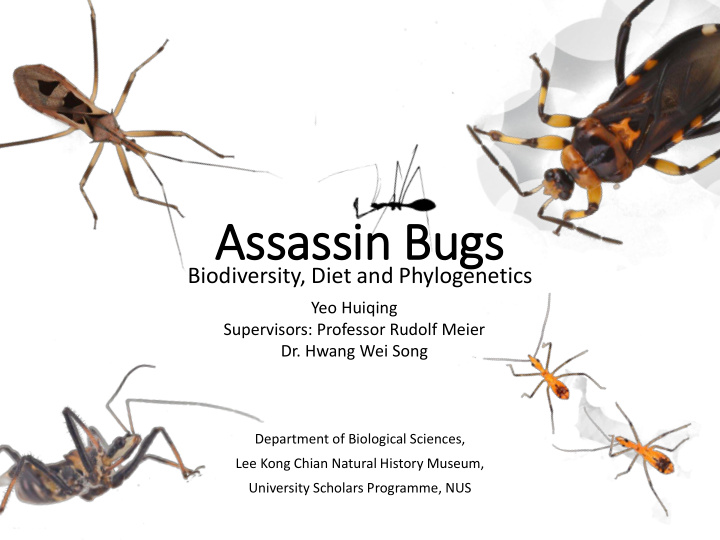



Assassin Bugs Biodiversity, Diet and Phylogenetics Yeo Huiqing Supervisors: Professor Rudolf Meier Dr. Hwang Wei Song Department of Biological Sciences, Lee Kong Chian Natural History Museum, University Scholars Programme, NUS
Piercing, sucking mouthpart A group of nymphs feeding Sycanus sp. feeding on grasshopper
Diverse Morphology Forelegs Other features Head
1. What is the species diversity of assassin bugs in Singapore? How do we identify them? Background • No checklist of assassin bugs in Singapore no baseline data • Lack of species information in Singapore online.
1. What is the species diversity of assassin bugs in Singapore? Checklist: 96 species (13 subfamilies) Materials and Methods • Field: Nature reserves, buffer areas and parks • Other sources: LKCNHM collection, catalogue, descriptions, keys and incomplete checklist
1. How do we identify them? 72 Species pages uploaded to the Animals and Plants of Singapore website Materials and Methods • Specimens and species records from the various sources mentioned • High resolution imaging using the Visionary Digital system • DNA barcoding via Next-Generation Sequencing
1. How do we identify them? Illustrated identification key (currently to genera uploaded) Materials and Methods • Specimens and species records from the various sources mentioned • High resolution imaging using the Visionary Digital system • DNA barcoding via Next-Generation Sequencing
1. How do we identify them? COI species barcodes (313bp) sufficient to identify reduviid species Materials and Methods • Specimens and species records from the various sources mentioned • High resolution imaging using the Visionary Digital system • DNA barcoding via Next-Generation Sequencing
2. What are they feeding on?
2. What are they feeding on? Salyavatinae L. annularis L. erecta L. inornata L. pallidispina L. rhypara Background • Salyavatinae widely assumed to be termite specialists based on literature on New World species • Observations in the field were unsuccessful
2. What are they feeding on? Materials and Methods • 49 specimens • Gut dissections metabarcoding via Next-Generation Sequencing (NGS) platform • Matched against databases (NCBI Genbank, local termite database)
2. What are they feeding on? Image credits: Foo Maosheng Macrotermes Hypotermes Odontotermes • 4 species of termite assassin bugs feeds on at least 10 species (6 genera) of termites. • Possible to retrieve multiple termite species from a tiny gut sample through NGS use method to expand and find out what other assassin bugs are feeding on.
3. How are they related? Evolutionary Species Ecological history information information
3. How are they related? Background • Phylogenetic relationships of termite assassin bugs (Salyavatinae) are unknown • Only a few species of Salyavatinae were represented in the most recent phylogenetic analysis. Salyavatinae representatives Lisarda pallidispina Valentia apetala Rhachicephala sp.
3. How are they related? Tracing the evolution of foreleg morphology Do the shape of T the forelegs relate to prey capture? Materials and Methods • Salyavatinae and reduviinae species from Singapore and Thailand • 5 genes (COI, 16S, 18S, 28SD2, 28SD3-5) • Phylogenetic analyses using TNT (parsimony) and RAxML-HPC2 (maximum likelihood)
Conclusion Species information Evolutionary history Ecological information
Acknowledgements Evolutionary Biology Lab Special thanks to: Amrita Darren Yeo Maosheng Ming Kai Sujatha Yuchen Dr. Cheong Loong Fah Eric Gordan NP/RP13-087-1
Thank You
Recommend
More recommend